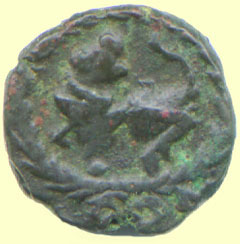 Contents -
Previous Article -
Next Article
Contents -
Previous Article -
Next Article
The Romans and Byzantines were fond of games and puzzles involving language. This image of a crouching lion on the reverse of one of the tiny AE4 coins of Leo is actually a rebus, or word - picture puzzle. The name Leo is the root of the Greek word for lion, making this coin of the "Lion Emperor" easy to identify even if one could not read at all!
The Eastern Roman Emperor Marcian died of illness in A. D. 457, leaving the throne vacant. This had often led to civil war in the past but the strong hand of Aspar, the Ostrogothic master general who had gained so much political power during the reigns of Theodosius II and Marcian. Aspar chose another professional military man, a Thracian by the name of Leo to succeed Marcian.
Leo was the first Roman emperor to be crowned by a bishop instead of a high - ranking or powerful senator. The bishops of the large cities had steadily been gaining power in the government and the Bishop of Constantinople, known as the Patriarch by the Eastern Orthodox Church, was arguably the most powerful. It is a testimony to the power that the church had gained and would continue to hold in politics that all future Byzantine emperors would be crowned by the Patriarch of Constantinople.
Early in his reign, Leo decided that Aspar and his Ostrogothic retainers held too much power for the well - being of the empire. He started to replace the German troops with Isaurian tribesmen from the mountains of Eastern Asia Minor (Modern Turkey). The citizens found these crude and insolent barbarians offensive, but Leo persisted in employing them. In fact, he allowed one Isaurian chieftain by the name of Tarasicodissa to marry his daughter Ariadne. Tarasicodissa took the more acceptable Greek name of Zeno and would succeed Leo as Emperor.
The one major event for which the reign of Leo is remembered was the disastrous attempt to recover the lost Roman province of Africa. Africa had been the major source of grain for the empire and had been lost to Gaiseric the Vandal chieftain in 429. The Western Roman Emperor Majorian and his master general Count Ricimer had tried to send a fleet of ships filled with Roman troops to oust the barbarian and reclaim the province in 460. The invasion plans failed when Gaiseric's pirate captains captured many of the ships in port and the land offensive in North Africa bogged met heavy resistance and poisoned wells. Ricimer had Majorian executed because of his failure. After his sack of Rome in 455 and his mauling of the roman fleet in 460, Gaiseric started gaining a reputation for invincibility. In 467, Gaiseric's pirate captains made raids against territory in Greece that was part of the Eastern Roman empire. Leo immediately retaliated with a fleet of his own and a military expedition funded with the enormous sum of 130,000 pounds of gold. 11,000 ships and 100,000 men were divided into two land forces and a naval fleet and sent to attack Gaiseric in a three - pronged attack. Leo had placed his own candidate Anthemius on the Western throne with the cooperation of Ricimer. The Western commander Marcellinus was to attack Sardinia and Basiliscus led the Eastern fleet to attack Sicily, where he sunk over three hundred Vandal warships. Basiliscus left Sicily and sailed for Carthage, intending to land and take the city. Meanwhile, the Eastern general Heracleius led a force overland to attack Carthage.
Again, due to a combination of luck and his choice of capable and ruthless commanders, Gaiseric thwarted the invasion plans. The Eastern fleet had entered the harbor at Cathage, and it almost seemed like it was all over for Gaiseric. The vandals sent fire ships against the Byzantine fleet in the night, and the wind carried them amongst the crowded war galleys. The next morning, the remains of Basiliscus' fleet limped back to Sicily. An agent of Gaiseric murdered Marcellinus in Sardinia, and Heracleius turned his army around when he learned of the disasters and marched back to Constantinople. The invasion, which had nearly exhausted Leo's imperial treasury, had come to nothing.
In 471, Leo had Aspar murdered during a period of anti German feeling by the people of the empire due to the great many barbarians in the military. In 473, Leo became seriously ill and indicated that his son should succeed him as Leo II. Leo died of his illness in 474.
Go to next article on Zeno
Go back to previous article on Marcian